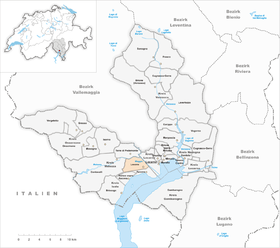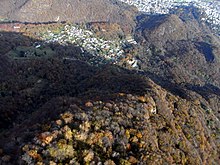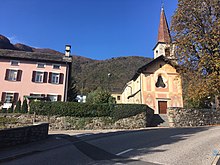Arcegno
| Arcegno | |
|---|---|
| State : |
|
| Canton : |
|
| District : | Locarno district |
| Circle : | Circle Isole |
| Municipality : | Losone |
| Postal code : | 6618 |
| UN / LOCODE : | CH RCT |
| Coordinates : | 700 756 / 113 019 |
| Height : | 387 m above sea level M. |
| Website: | www.losone.ch |
| map | |
Arcégno is a fraction of the municipality of Losone .
geography
The village is located around three kilometers west of Losòne on a cleared plateau, in a forest clearing, near the municipal boundary of Ascona . The winding cantonal road (Italian via cantonale ) overcomes the height difference of 150 meters from the center of Losone to the church in Arcegno. It then leads south and flatter through a new quarter, forest and the nature reserve above Monte Verità in the direction of Ronco sopra Ascona , where the view opens up to Lake Maggiore beforehand . Another, but narrow and restricted road, the Polenweg, leads north towards Golino , on the western side after half a kilometer is Campo Pestalozzi.
In the originally agricultural village there is a small core with medieval houses, the Catholic Church of Sant'Antonio Abate and a cemetery. After the Second World War, a new quarter with mostly single-family houses was built south of it. At the same time, due to the decline in agriculture, the forest has moved very close to the village.
Arcegno is a starting point and transit point for hikes in western Locarnese. There is an extensive network of hiking trails through chestnut and beech forests in Val Brima, Val Riò, Monti di Losone, Val da Chècc, Busbera and Barbescio, through the nature reserves Collina di Maia and Gratena and to the Balladrüm viewpoint .
history
The peat camps of Arcegno, the rock shelters of Quarigo and the petroglyphs on soapstone and gneiss seem to confirm that the area has been inhabited since the Neolithic .
The hamlet of Arcegno belonged to Losone as early as the Middle Ages. The inhabitants had to pay tithes on vines and grain to the nobles of Locarno. The Church of Sant'Antonio Abate was built between 1347 and 1357. This was expanded in the 15th century, the church tower was built between 1560 and 1565, and later a new choir and new church windows were added. Today it is considered a historically significant building.
Many people emigrated from the village to Italy. In 1832, the “Compagnia di Roma”, which had been founded by these emigrants in 1815, donated the big bell, as is customary at these societies, to beautify the church, had the crucifix chapel decorated and donated the stations on the road leading to the church. The "Compagnia di Firenze" gave her a picture of the Virgin that is hung behind the main altar.
In 1929 the "Campo Enrico Pestalozzi" was founded and built up on the initiative of the Lucerne pastor Julius Kaiser and with the help of young people. From 1941 to 1947, Polish and Ukrainian soldiers were interned in the Losone-Arbigo district, who had built the “ Polenweg ” from Arcegno to Golino in 1941 to 1945 in partly steep and rocky terrain. A Polish coat of arms embedded in the rock commemorates the achievements of the internees during the Second World War. The period after the Second World War was marked by the decline in agriculture and the associated handicrafts, the advance of the forest and the construction of new houses for both residential and holiday purposes.
population
| Population development | |||
|---|---|---|---|
| year | 1591 | 1902 | 1910 |
| Residents | about 200 | 77 | 92 |
traffic
Arcegno is accessible to the public with the number 314 bus of the Ferrovie autolinee regionali ticinesi (FART). This bus runs from Locarno train station via Losone and Arcegno to Ronco sopra Ascona and back the same way.
Campo Enrico Pestalozzi
In 1929 the Campo Enrico Pestalozzi was founded and built up on the initiative of Lucerne pastor Julius Kaiser and with the help of young people. It has become a holiday village and place to stay for holiday, class, confirmation, apprentice and sports camps as well as for school trips and adult groups, which is frequented by the majority of German-speaking Swiss in the summer months. On an area of around 35,000 m², the Campo offers space for over 300 people in ten simple, functional pavilions; these buildings are surrounded by chestnut trees.
Attractions
- Church of Sant'Antonio abate. The current church dates from the 17th century; it replaced a chapel dedicated to St. Anthony, which was built between 1347 and 1357.
- Oratory Madonna della Valle (17th century)
- House Pinoja-Lutz, in Via ai grotti, architects Franco and Paolo Moro (1994)
- Casa Righetti house, in Via Loco, architect Michele Arnaboldi (1991).
- Various bowl stones in the district of Busbera (550 m above sea level), il Sasso magnetico (500 m above sea level), il masso di Bedrüsc
Personalities
- Gustav Gräser (1879–1958), philosopher, writer, poet, artist
- Jakob Flach (1894–1982), writer, puppeteer and painter
- Paul Kaiser (1905–1978), pastor of St. Theodor in Basel , co-founder of the Campo Enrico Pestalozzi youth camp.
literature
- Rodolfo Huber: Losone. In: Historical Lexicon of Switzerland . June 2, 2009 , accessed January 7, 2020 .
- Simona Martinoli u. a .: Arcegno. In: Guida d'arte della Svizzera italiana. Edizioni Casagrande, Bellinzona 2007, p. 204.
- Celestino Trezzini : Arcegno In: Historisch-Biographisches Lexikon der Schweiz , Volume 1: Altheus - Ardüser. Attinger, Neuenburg 1921, p. 413 ( digitized version ).
Web links
- Arcegno on elexikon.ch
- Arcegno on ticinarte.ch
- Campo Pestalozzi website
Individual evidence
- ↑ Walking and Nordic walking route around the Maia hill, north of Arcegno
- ↑ Arcegno on biblio.unibe.ch/digibern/hist_bibliog_lexikon_schweiz (accessed on May 28, 2017).
- ↑ Campo Pestalozzi website
- ^ Rodolfo Huber: Losone. In: Historical Lexicon of Switzerland . June 2, 2009 .
- ^ Arcegno. In: Geographical Lexicon of Switzerland , first volume: Aa - Emmengruppe. Attinger Brothers, Neuchâtel 1902, p. 87 ( digitized version ).
- ↑ Celestino Trezzini: Arcegno. In: Historisch-Biographisches Lexikon der Schweiz , Volume 1, Altheus - Ardusser. Attinger, Neuenburg 1921, p. 413 ( digitized version ).
- ↑ FART bus lines = 20
- ↑ Campo Pestalozzi website
- ↑ a b c d Simona Martinoli u. a .: Guida d'arte della Svizzera italiana. Published by the Society for Swiss Art History , Edizioni Casagrande, Bellinzona 2007, ISBN 978-88-7713-482-0 , p. 204.
- ^ Franco Binda: Il mistero delle incisioni. Armando Dadò editore, Locarno 2013, pp. 83–85.







